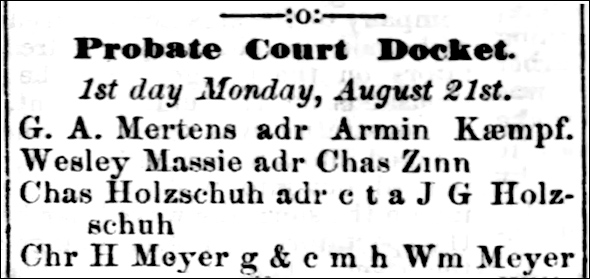The language of the law. Part Latin, part Greek, part law French, even part Anglo-Saxon. And all confusing.
It was published in a Missouri newspaper in early August 1876.
The kind of report The Legal Genealogist just loves to see.
Under the heading “Probate Court Docket,” we find what was scheduled for the first day of the Probate Court session — to be held on Monday the 21st of August, and on the following three days.
Wonderful!
Except…
Sigh…
The newspaper docket list is chock full of legal alphabet soup.

In just this snippet from the Advertiser Courier, we find ourselves wading through it: “adr” and “adr c t a” and “g & c m h.”1
Oy…
Now if we’ve been working with probate records long enough, we can probably figure out that “adr” is the abbreviation the paper used for “administrator” — the person chosen by the court to handle the estate of a person who died without leaving a valid will.2
But then what’s the “c t a” bit? Which — sigh — you won’t find in the law dictionary as part of the definition of administrator…
Oh, you will find it in the law dictionary. At the start of the C letter entries in the abbreviations: “An abbreviation for cum testamento annexo, in describing a species of administration.”3
Well, that was helpful, wasn’t it?
So we’re off to another page, where we find that “cum testamento annexo” means “With the will annexed. A term applied to administration granted where a testator makes an incomplete will, without naming any executors, or where he names incapable persons, or where the executors named refuse to act.”4
Okay, got that.
So what about that “g & c m h” thingy?
I have to admit that one had me stumped for a minute. I was pretty sure we were talking about a guardian of minor heirs… But the “& c” part made me think.
Missouri, you may recall, was smack dab in the middle of the Louisiana Purchase. Meaning its earliest legal history was not under the English common law but rather under the civil law of France and Spain — and it carried that civil law tradition over into its early days as an American territory, modeling its courts after the French and Spanish legal system.5
And that civil law system used the term curator rather than guardian.
Was that it? Yep. Look up curator in Black’s Law Dictionary and it says: “In Missouri. The term ‘curator’ has been adopted from the civil law, and it is applied to the guardian of the estate of the ward as distinguished from the guardian of his person.”6
So the guardian took care of the child — making decisions about schooling and clothes and more, the curator took care of the child’s property, and the court could name one person to handle both roles.
Legal alphabet soup for sure… but digestible in small bites with the help of a good legal dictionary… and an appreciation of the history of time and place.
Cite/link to this post: Judy G. Russell, “Legal alphabet soup,” The Legal Genealogist (https://www.legalgenealogist.com/blog : posted 13 Dec 2022).
SOURCES
- “Probate Court Docket,” Advertiser Courier, Hermann, Missouri, 4 August 1876, p. 4, col. 3; digital images, Newspapers.com (https://www.newspapers.com/ : accessed 13 Dec 2022). ↩
- See Henry Campbell Black, A Dictionary of Law (St. Paul, Minn. : West, 1891), 40, “administrator.” ↩
- Ibid., 162, “C.T.A.” ↩
- Ibid., 308, “cum testamento annexo.” ↩
- See “The Bicentennial of the Missouri Judiciary: 1812–Missouri organizes as a territory,” Missouri Courts (https://www.courts.mo.gov/ : accessed 13 Dec 2022). ↩
- Black, A Dictionary of Law, 309, “curator.” ↩
* This article was originally published here
Colburn Hintze Maletta is a Phoenix Criminal Defense and Family Law Firm. Visit them at https://chmlaw.com

Social Plugin